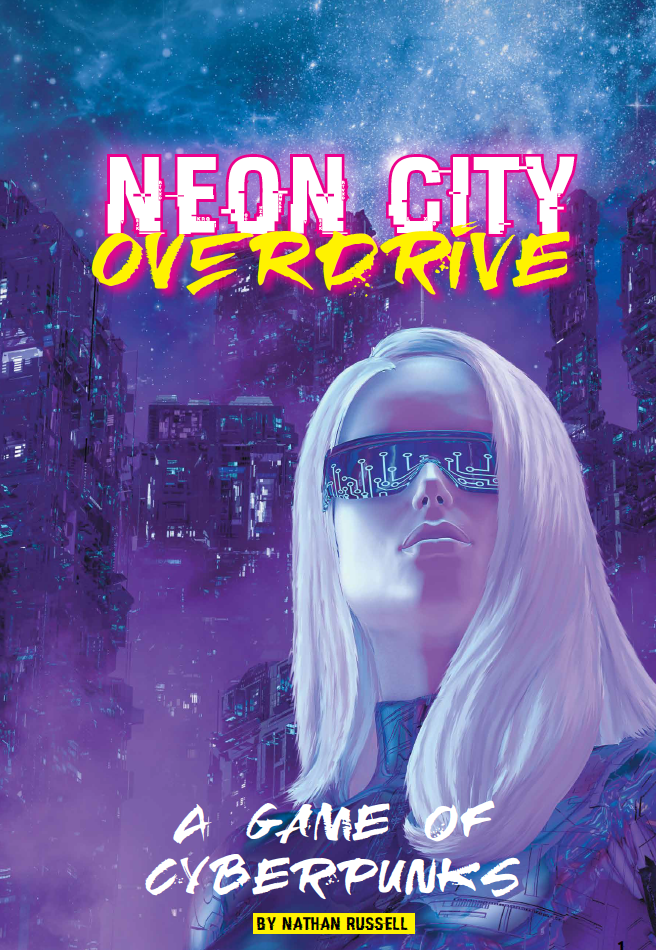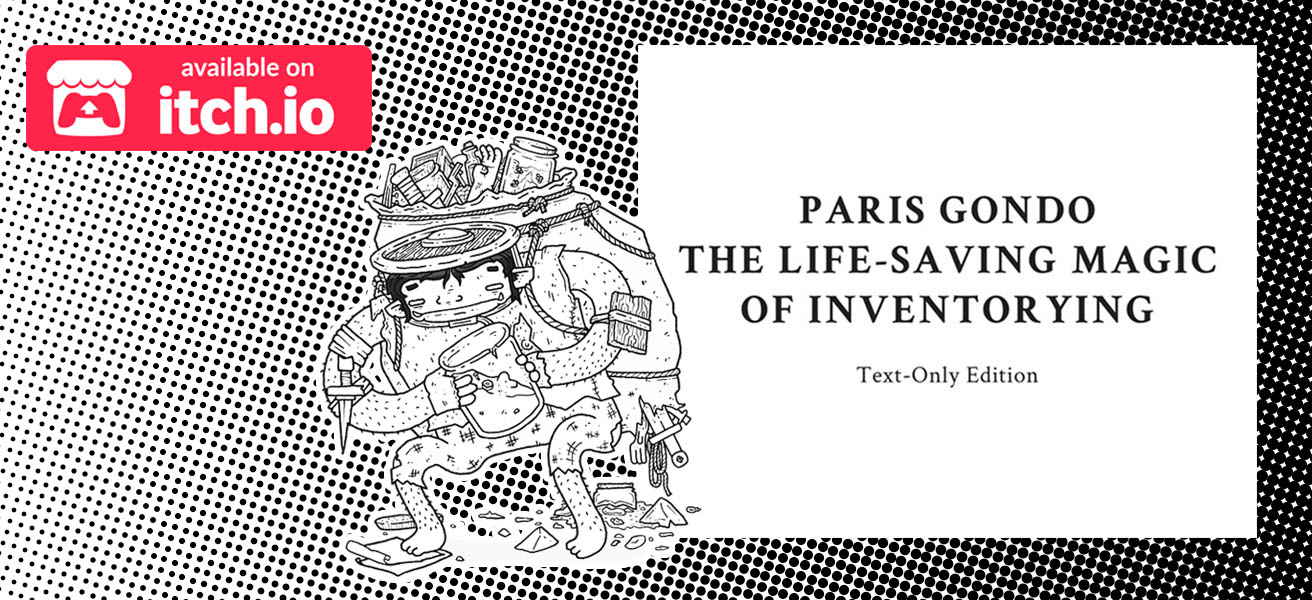Review of Neon City Overdrive

While ARC: Doom Tabletop RPG is completely in line with my main genre, fantasy, cyberpunk is something I consume in movies, books and games, but hardly ever play in the TTRPG space. Still, I found three other friends who want to play cyberpunk with me. All with different backgrounds (Shadowrun, Blade Runner / Savage Worlds and Cyberpunk 2077) met at the table to play something cyberpunk. We didn’t want to play the classic get-in, get-out thing. While Benjamin from the round led his own Savage Worlds cyberpunk round and kept raving about Sprawlrunners*, I wasn’t in the mood to deal with Savage Worlds completely again at the moment and wanted to try something lightweight. I heard about Neon City Overdrive and the positive opinions about it. And this is where the intro ends and we turn to the question: Yes, well, but what is Neon City Overdrive?
This post contains affiliate links, which are marked with a “*” in the name.

- Publisher: Peril Planet Funeral
- Release Year: 2020
- Language: Englisch
- Pages: 72
- Format: PDF / Print
- Price: 9.99 $ / 19.99 $ for Softcover Premium Color / 25.99 $ for Hardcover, additional bundles and variants at DriveThruRPG*
Neon City
At its core, Neon City Overdrive wants to be a science fiction / cyberpunk game that sets a dark and dystopian tone. The author cites Akira, Altered Carbon, Blade Runner, Cyberpunk 2020, Dredd, Ghost in the Shell, Neuromancer & the Sprawl Trilogy, The Matrix and many more as influences. There is a very openly described city in the basic rulebook. Mostly only types of districts are mentioned like the Grinders, which are huge industrial complexes where products and people are created and exhausted 24/7. In the Metroplexes, in complexes of high-rise buildings over several blocks, people live in a society that seems like a small self-contained city. There are living areas, entertainment centers, shopping. Basically, a plexer does not have to leave their metroplex.
But there is also the world beyond the city. Outside the city, the No-Zone reigns. Due to wars, pollution, and destructive management, the city’s surroundings have become an endless wasteland and are uninhabitable. Only the toughest nomads live here, as well as those who did not want to leave their old homes.
In orbit above the city, the rich and privileged live in space colonies. Most people here have ghost chips, which allows them to live indefinitely, as their memories and personality are stored on these chips. In addition, there are colonies on Mars and the Moon. This is where the richest and most powerful orbitals live.
Technology and Science
What science, future and technology brought to people in Neon City Overdrive is relatively open. This is the point where Neon City Overdrive calls itself a sandbox. Facebook still exists with you guys? All right, why not. The world of Neon City Overdrive merely provides the framework and basic ideas. Thus, life has been upgraded through cybertech (drones, cyberware, robots, AI, organ replacement), gene hacking and thus genetic modification, clones and DNA manipulation.
The Grid serves as the modern version of the Internet. The Grid is ubiquitous and the primary source of information and news. Almost every device is connected to the grid and most people are chipped to access the grid through an interface.
So basically your ordinary cyberpunk setting.

The Basics
The engine of Neon City Overdrive is a mix of different systems. Those mechanics are similar to those from Fate and Blades in the Dark. Even the Drive Track I would attribute to Ironsworn as an inspiration, but maybe only because the mechanism was rarely presented to me in this form and is omnipresent in Ironsworn.
Trademarks, Edges and Flaws
Trademarks are defined by you during the character creation. I won’t go into the character creation here, in order not to go beyond the scope. Trademarks are characteristics of your character’s concept. This can be a special background (e.g. No-Zoner, Orbitaler, Metroplexer, Gene-Bred), a role (like Decker, Gunner, Medic), your physical characteristics (e.g. because you have a genetic modification or cyberware), etc. You are relatively free to do what you want. This is again reminiscent of the aspects in Fate.
The characteristics result in triggers. For example, being a bounty hunter means you are good at tracking, intimidating, shooting, disarming, tracking, fighting, following evidence, and so on. In Neon City Overdrive, many categories for characteristics are presented. You can make use of these or use them as inspiration for your own Trademarks.
You choose your Edges and Flaws from the Trademarks. As a bounty hunter you are not only advantaged, but also cold-hearted, only in it for the money or soft-hearted. Specialties are things you are particularly good at. All bounty hunters can track people, but you are especially good at it. Flaws are exactly the opposite – something that makes your life more difficult.
Checks
A pool of dice is formed during a check. This results from the Trademarks of your character, his Edges and the Flaws. The back of the work is thankfully a brief summary of the rules. When you form a dice pool, you get Action dice and Danger dice. Action dice depend on
- your Trademarks
- Edges
- a tag you can exploit of an enemy, object or scene (we get to that in a bit),
- advantageous position,
- used special gear.
You get Danger dice for
- Trauma of your character (you get trauma if you are at 0 hit points),
- any negative condition (short-term penalties of a scene, like getting furious, being frightened, etc.),
- Tags or details of a scene, enemy or object that make the situation more complicated,
- missing gear,
- an hinderance.
On a check, all these dice are now rolled. Results of 1 – 3 are a failure, 4 – 5 a partial success and 6 a full success. Danger dice cancel out Action dice that have the same value. So, for example, if a 6 was rolled on a Danger die and an Action die, the 6 is not scored. There are still critical successes (Boon) when 2 or more 6s are rolled and critical failures (Botch) when all action dice are cancelled out or the only action dice scored are 1s.
As an increased difficulty, you can have extended checks made, which then require three successes. Partial successes also count as a success.
Basically, partial successes carry a complication, but are still a success. This is familiar from PbtA games, where if we get a -6 we have a failure and if we get a 7 – 9 we have a partial success with a consequence, but basically succeeding in our endeavor.
Combat
Offensive and defensive actions are checks as well.
There are two types of actions: Quick Action and Focused Action. Quick actions are attacks, saying something witty, taking an object, throwing something to someone, applying first aid. Focused actions are actions that require a little more attention. For example, this can be a precise shot, moving very far, hacking something, defusing a bomb, or looking at something more closely. Again, these are just examples of the statement: there are fast actions and slow actions. In each round, a character may move and perform a quick action or perform a long action without moving.
Movement in Neon City Overdrive works via zones. There are Close, Near, Far, and Distant. A single move (as part of a quick action) allows you to change one zone (e.g. from Near to Far). A concentrated action as a movement allows to change two zones (e.g. from Far to Close).
Stunt Points
Stunt Points are the fate points from Neon City Overdrive. They allow you to use another Trademark for a check, soak up damage on a hit, change a die result by +1 or -1 (helpful for avoiding a Danger die), or add a detail or tag to a scene.
Stunt points are awarded at the beginning of each job or when you act out a Flaw from your character and incorporate it into the story to cause significant complications for yourself and others. Of course, the game master can also award stunt points for various reasons.
Overdrive
Neon City Overdrive actually wants to be played mission-based. The game offers the job structure for this. There are
- A hook and employer.
- Gearing up (there are gear rolls at the beginning of every job).
- The Job.
- Conclusion of the job and entering downtime.
Excursion: Gear Rolls
The gear rolls abstract some legwork. Each character can have four special items. These are items with quirks, such as the discreet, agile van. d6 is rolled for each item. If the result is higher than or equal to the number of traits, the character gets the item.
A job is played in several scenes. For this, Neon City Overdrive offers something similar to the fronts from Dungeon World: The Rule of COOL. COOL stands for
- Concept: What’s the cool basic idea or concept of the job?
- Objective: What is the goal or objective of the job?
- Obstacle: What’s a hinderance to the characters?
- Link: How does this job relate to previous jobs?
Neon City Overdrive supports the creation of jobs with a job generator and a one page template for the job. Here COOL, the individual scenes can be noted in a few lines as well as the threats at the job.
Threats
Threats are enemies in Neon City Overdrive. Whether AI, ICE, robots or people. They have a hit track, just like the characters of the players. Depending on whether they are bosses or the Big Bads, the hit tracks are merely extended, making these characters more resistant. Otherwise, each threat has a motivation (Drive), characteristics and special actions. Very short and thematic.
Neon City Overdrive offers some threats as examples, but also allows you to quickly build your own threats due to the short format.
Clocks
Like Blades in the Dark or ARC, Neon City Overdrive also refers to the use of clocks at the table. These are meant to build up stress and indicate that something is going to go down south or a complication is looming. As an example, it is mentioned that when trying to gain access to a computer, the password may only be entered three times. The clock starts at 3 and decreases after each unsuccessful attempt.
Downtime and Advancement
The downtime in Neon City Overdrive revolves around the characters after a job. To represent the characters’ reason for taking on these missions, each character has a Drive. This motivation is formulated as a goal. For example, one may want to save his sister from a deadly disease. One would like to escape the life on the street. More selfish goals would involve the character’s retirement, that is, having enough money to make a nice life for himself.
This Drive is recorded in a progress track. Each time the character makes progress, a check mark is placed in one of the boxes on the bar. If you miss a chance or lose too much time to reach your goal, a cross is placed. Once the track is filled, a test is taken to see if one reaches the goal and can retire. The dice pool is here: For each hook there is an Action die, for each cross there is a Danger die.
You can also buy progress for your Drive. After each job there is a Leverage. This payment is rolled and can be spent to heal yourself from trauma, buy experience points or buy a new body. The last option is to pursue your dream and get progress on the Drive Track.
Experience points are awarded after each job. There is one experience point for each Botch and one experience point for surviving the job. These experience points can be spent to gain a new Trademark, learn a new Edge, increase health by one, and increase the maximum stunt points. However, all these improvements are limited and do not end in a power creep.
Presentation
Neon City Overdrive has a clean layout, short paragraphs and explains precisely the system and intention. It doesn’t look too playful with the color, but you can feel the neon of the city flickering through as you read. The images chosen as illustrations are fitting and show mountains of data, rainy cities of the future, and street samurai battles. Especially nice is the structure of the chapters and that on the back is a summary of the core rules.
It should be mentioned again that Neon City Overdrive explains the setting, the mechanics, has a section for the game master and there briefly explains concepts of PbtAs and narrative games – because that’s what Neon City Overdrive wants to be – and even offers the construction of jobs as well as a generator including a bestiary. It is a self-contained work on a few pages.
Conclusion
While reading, I liked the idea that Neon City Overdrive conveys. You can tell the game has influences, but they seem well orchestrated and coordinated. As in Tricube Tales, we build dice pools based on appropriate Trademarks of our character rather than skill and attribute values. At the same time, we’re talking about soft and hard consequences for partial successes, which do exist. Not every roleplaying game leaves the binary haven of skill check results.
The setting is told in outline. It isn’t fleshed out and doesn’t offer a city map. If you don’t need something like that, you’re well served here with the ideas Neon City Overdrive conveys. If you need a sophisticated setting, however, you can probably unleash Neon City Overdrive on other cyberpunk settings without loss. Expansions include extension rules for Skins and the Ghost Chips, Psionics, and the Grid. Instead of a polished world, there are helpful tips for game mastery, a cool template for adventures, and also character motivation that encourages campaign play.
In my opinion, Neon City Overdrive sounds like a cool little game that can be expanded very well because statblocks of threats are small and features can be made very flexible. The whole engine isn’t even heavily tied to cyberpunk and can be hacked for many other genres and settings.
As someone who doesn’t like much of Fate’s rules construct, I really liked the implementation of virtually the same idea in Neon City Overdrive. Get rid of +2 here and +2 there. Just add Action dice or Danger dice and go.
Outlook
There will probably be another review after a few rounds of play. At the time of writing, I have the first round behind me, but not on a mission basis in the sense of runs, as is usually the case in Shadowrun and in Neuromancer style. I suspect that this consideration will be exciting once again, as our mini-campaign is intended to move in the direction of mystery-noir.








